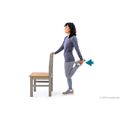Osteoarthritis: Exercising With Arthritis
Overview
When you have arthritis, exercise and activity can help you to:
- Feel better and make daily tasks easier to do.
- Reduce joint pain and stiffness.
- Prevent damage and injury to your joints.
- Prevent arthritis from getting worse.
- Keep your muscles strong. Weak muscles can put added stress on your joints.
- Improve balance. Exercises that stretch and strengthen the muscles and joints can help older adults keep their balance, which can help prevent falls.
- Reach and stay at a healthy weight.
Movement also pumps fluid in and out of the joint space, which helps your joint stay healthy. When you don't move as much, you lose some of that natural pump action.
How can you get started with exercise?
Aerobic, strengthening, and range-of-motion exercises can help arthritis. When you combine these types of exercises, they can help protect your joints and keep them flexible. They also make your joints, heart, and lungs stronger.
Aerobic activity
Aerobic exercise makes your heart and lungs stronger and builds your endurance.
Talk to your doctor before you start an exercise program or activity. Ask what kind of exercise is best for you and how to exercise if a joint is sore or swollen.
When you start an exercise program or activity, start slowly, and don't push yourself too hard. Pace yourself. For example, do 10 minutes of activity at a time, 1 or 2 times a day. Then work your way up to where you can do it for a longer time. Aim for at least 2½ hours of moderate activity a week. One way to do this is to be active 30 minutes a day, at least 5 days a week. Pacing yourself is especially important if you haven't exercised for a while.
There are many ways to get aerobic activity.
- Walk as much as you can.
You can walk outdoors through your neighborhood or on city paths. Or walk indoors on a treadmill or at the mall.
- Work out in a pool.
The water helps take the weight off painful joints, and it provides some resistance.
- Try walking in water that is up to your waist or your chest.
- Swim at your local health club, YMCA, or neighborhood pool. Many locations offer classes designed for people with arthritis.
- Bike outdoors, or use an indoor bike.
- Try an online video, or use an exercise app for smartphones.
- Be more active in your daily routine.
Doing vacuuming, housework, gardening, or yard work can all be aerobic.
Strength exercises
Strength exercises can make muscles around a joint stronger and help protect and reduce stress on your joints. For example, stronger thigh muscles can help reduce stress on your knees and hips.
Before you start to do strength exercises, ask a physical therapist or your doctor which exercises would be best for you. And ask how to do strength exercises safely so you don't get hurt. Exercise books, videos, and phone apps can also show you how to do strength exercises the right way.
Here are some ideas for doing strength exercises.
- Lift light weights, dumbbells, or cans of food, or use exercise bands.
You can find these at a community gym or fitness club or use them at home.
- Use an exercise machine at home or weight machines at a gym or club.
Range-of-motion exercises
These types of exercises help keep you flexible and can improve your range of motion in a joint. They can help prevent stiffness, injury, and more damage to your joints.
Here are some ideas.
- Move each joint.
Move your joints as far as you can in each direction without causing pain, 8 to 12 times each day. Remember to do all the little joints too, such as those in your fingers.
- Do long, slow stretches.
- Stretch slowly. Stretching is not about going fast or making sudden movements.
- Don't push or bounce during a stretch
- Hold each stretch for at least 15 to 30 seconds, if you can. You should feel a stretch in the muscle, but not pain.
- Breathe out as you do the stretch. Then breathe in as you hold the stretch. Don't hold your breath.
- Try exercises that target a certain joint.
For example, if you have arthritis in your knee, try some stretches for the legs, such as the calf stretch, quadriceps stretch, and hamstring stretch.
Ice and heat after exercise
For moderate to severe pain from osteoarthritis, try applying heat and cold to the affected joints. Experiment with heat and cold techniques until you find what helps you most.
You might try hot compresses or cold packs. You can also try switching between heat and cold.
- Apply heat 2 or 3 times a day for 20 to 30 minutes to relieve pain and stiffness. But don't use heat if the joint is swollen or hot.
- Put ice or a cold pack on your sore joint for 10 to 20 minutes at a time. Put a thin cloth between the ice and your skin.
Paraffin wax is a form of moist heat that may help if you have pain and stiffness in your hands or feet. It's especially useful before exercise. Your physical therapist can teach you to use wax at home.
After heat or cold treatments, try gentle massage for relaxation and pain relief.
Credits
Current as of: July 24, 2025
Author: Ignite Healthwise, LLC Staff
Clinical Review Board
All Ignite Healthwise, LLC education is reviewed by a team that includes physicians, nurses, advanced practitioners, registered dieticians, and other healthcare professionals.
Current as of: July 24, 2025
Author: Ignite Healthwise, LLC Staff
Clinical Review Board
All Ignite Healthwise, LLC education is reviewed by a team that includes physicians, nurses, advanced practitioners, registered dieticians, and other healthcare professionals.








